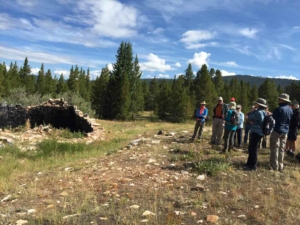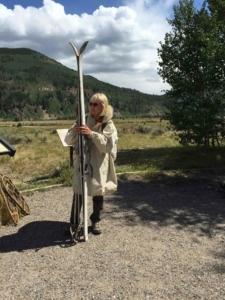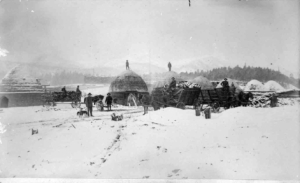Sawatch and Saguache
Sawatch and Saguache: Colorado place names
and their Ute language origins
by Lynn Albers, April 2021
At a recent board meeting of the Eagle County Historical Society (ECHS), the proposed Gore Range name change by the Summit County Commissioners was discussed. The Summit County commissioners have petitioned the U.S. Board on Geographic Names to consider re-naming the Gore Range. The commissioners noted the name, “Nuchu Range,” as their preferred choice for the mountain range. Nuche was the Ute people’s name for themselves. Nuche or Núu-chi means “human, person, Indian or Ute,” according to Dr. Talmy Givón, a University of Oregon linguist. The Nuche are the original inhabitants of the Colorado mountains, including the Eagle and Summit county region.
I recalled an earlier discussion about the Ute-derived name, Sawatch, with Nathan Boyer-Rechlin, Community Outreach Coordinator of Walking Mountains Science Center. ECHS often partners with other non-profit organizations, including Walking Mountains, for some excellent educational offerings. Inspired by the ECHS board discussion and prior conversation with Nathan, I set out to research the Colorado geographic place names Sawatch and Saguache.
Utes of the Colorado Mountains:
The Utes, whose self-name is the Nuche, were the original Native Americans of what is now Eagle County, Colorado. The Nuche lived in family groups and practiced a nomadic hunter-gatherer lifestyle. Periodically, the Ute family groups united as extended family bands for seasonal hunting, gathering of plant resources, social enjoyment, and ceremony. Ute is a Southern Numic language within the Shoshonean branch of the Uto-Aztecan language family. The Ute language has Northern and Southern dialects that are often mutually intelligible.
Prior to European-American settlement, the landscape that is now Eagle County served as Ute hunting grounds, travel interface, sites for ceremonies, open camps, and villages in addition to workstation sites for subsistence gathering and processing, and weaponry manufacture. The Yampatika (Yampa Ute), as well as the Parianuche (Grand River Ute), Nupartka (White River Ute), and Tabeguache (Uncompahgre Ute), frequented this area. Together these Ute bands, alongside the Uintah Ute formerly occupying far northwestern Colorado and northeast Utah, are often known as the Northern Utes. Between 1861 and 1881, these Ute bands were removed to northeastern Utah reservations. The 1879 Meeker incident and various 1860s executive orders and treaties were the impetus and legal apparatus for this removal.
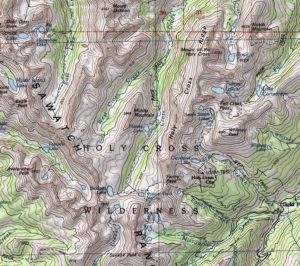
Sawatch Range topo map
Sawatch Mountains and Town of Saguache:
Sawatch (pronounced SAH-watch or sah-WATCH) and Saguache (usually pronounced sah-WATCH) are both derivations of same Ute word roots. The Sawatch Mountain Range emerges in Eagle County south of the Eagle River and stretches south for approximately 100 miles. Trending north to south and aligning with the Continental Divide from Tennessee Pass in Eagle County to Marshall Pass in Saguache County, the Sawatch Range hosts some of the highest mountains in Colorado. The Sawatch Range includes the highest peak in Eagle County, the Mount of the Holy Cross. The 14,011’ iconic peak is located within the Holy Cross Wilderness Area, which is administrated by the White River National Forest.

Sawatch Range viewed from Brush Creek 1920s
Located south of the Sawatch Mountain Range in the San Luis Valley is the community of Saguache. The town of Saguache is the county seat of Saguache County. Ute peoples in this area often camped near the area’s primary waterway, Saguache Creek. The town of Saguache was founded during the 1860s after the Utes were removed from the area. Ute treaties in 1863 and 1868 were the legal apparatus for this removal.
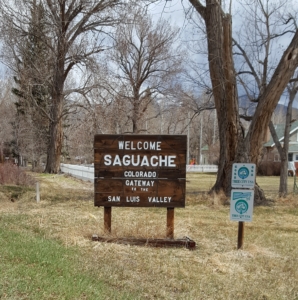
Entering the town of Saguache
Discussion:
There are several interpretations for the Ute geographic place name, Sawatch or Saguache. In his book, Land of the Blue Sky People: A Story of the San Luis Valley, Luther Bean states that the Ute word Saguache means “blue water.” Dr. Bean became one of the first faculty members of Adams State Normal College (now Adams State University) in Alamosa, Colorado in the early 1920s. The institution is home to the Luther E. Bean Museum, which features San Luis Valley regional art and history.
In her book, Utes: The Mountain People, Jan Pettit states that Saguache is a Ute word that means “Blue Earth” or “Water at the Blue Earth.” In addition to being the founder of the Ute Pass Historical Society, Pettit developed educational programs with the support of the Ute community. She also produced a documentary entitled Bear Dance. The Bear Dance, mama-kwa-nhka-, essentially meaning “woman-step-dance,” is the annual life renewal ceremony of the Utes. Held today in late spring or early summer, Ute Bear Dance traditionally occurred at the first springtime thunder.
In her University Press of Colorado publication, Ute Indians of Utah, Colorado, and New Mexico, Virginia McConnell Simmons states that Sawatch and Saguache evolved from the Ute word saguguachipa. According to Simmons, the term means “Middle Earth” or “Blue Earth” and refers to the foothills, mountain valleys and mountain parks of the Utes original homeland.
The Ute language is vulnerable due to the passing away of Ute elders, who are today’s fluent speakers. In 1975, Southern Ute tribal chairman, Leonard Cloud Burch, initiated the Ute Language Program. Built upon the linguistic study of Dr. James Goss, linguist Dr. Talmy Givón, partnered with the Southern Ute Tribe and its Ute Language Committee to publish a Ute language collection of works. A perennial program was established to teach Ute language to younger tribal members. Elders and cultural heritage representatives who spoke other Ute dialects were (and are) consulted in order to preserve a common language.
According to Givón and the Ute Dictionary, the Ute term saghwa refers to hues of green or dark blue. The place name Saguache, Colorado likely derives from the Ute word saghwa-chi meaning “greenery, green spot” or “oasis.” A similar term, saghwa-gha-na-chi, may also have a bearing on the geographic and place names Sawatch and Saguache. This Ute term, used to indicate the Northern and/or White River Ute peoples, literally means “at the Green.” Givón states this probably refers to the Green River which flows through a portion of northwest Colorado. He further reports that the term may have originally been saghwa-gha-nuu-chi meaning “Green River Ute” and that this term may be the source of an early Spanish name for the Northern Ute, the “Yutas Sabeguanas.” The earliest record of this Ute name was documented by Juan Maria de Rivera in 1765. In 1776 Franciscan priests Dominguez and Escalante also recorded the name, Yutas Sabguanas, during their exploration of western Colorado.
Author
Lynn Albers is the local history and ethnobotany specialist at Vail Public Library. She also helps administrate the Eagle County Historical Society museum in Eagle and has consulted for Ute ethnobotany and ethnohistory projects.
References
Bean, Luther E. Land of the Blue Sky People: A Story of the San Luis Valley. Monte Vista, CO: The Monte Vista Journal, 1962.
Givón, Talmy with Pearl Casias, Vida Peabody and Mary Inez Cloud. Ute Dictionary. Volume 15. Philadelphia: John Benjamins Publishing Company, 2016.
Jacobs, Randy, ed. and Robert Ormes. Guide to the Colorado Mountains. 10th ed. Golden CO: Colorado Mountain Club Press, 2000.
Janet Pettit 1937 – 2018. Obituary. Gazette.com. https://obits.gazette.com/obituaries/gazette/obituary.aspx?n=janet-pettit&pid=188089003.
Jones, Sondra G. Being and Becoming Ute: The Story of an American Indian People. Salt Lake: University of Utah Press, 2019.
Luther Bean Museum. Alamosa, CO: Adams State University. https://www.adams.edu/lutherbean/ (Accessed 6 September 2020).
Nuchu Range. Case Brief (Domestic) #5410. United States Board on Geographic Names. file:///C:/Users/Owner/AppData/Local/Temp/Nuchu%20Range%20proposal%20packet.pdf
Pettit, Jan. Utes: The Mountain People. Revised ed. Boulder CO: Johnson Publishing, 1990.
Saguache County. Colorado Encyclopedia. https://coloradoencyclopedia.org/article/saguache-county (Accessed 6 September 2020).
Simmons, Virginia McConnell. Ute Indians of Utah, Colorado, and New Mexico. Boulder: University Press of Colorado, 2001.
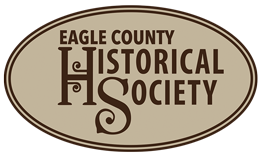
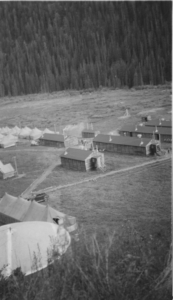
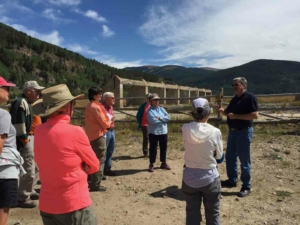 Hikers spent the morning up on Tennessee Pass, checking out the 1880s charcoal kilns used to create fuel for mine smelters.
Hikers spent the morning up on Tennessee Pass, checking out the 1880s charcoal kilns used to create fuel for mine smelters. 